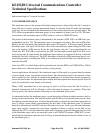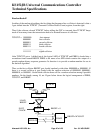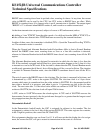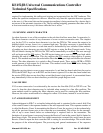
KS152JB Universal Communications Controller
Technical Specifications
Kawasaki LSI USA, Inc. Page 47 of 120 Ver. 0.9 KS152JB2
The highest slot assignment in the network is written by each station’s software into its TCDCNT
register. Normal the highest slot assignment is just the total number of stations that are going to
participate in the backoff algorithm.
In deterministic backoff mode a collision will not cause a 1 to be shifted into TCDCNT. TCDCNT
will still be ANDed with PRBS and the result loaded into BKOFF. In order to insure that all sta-
tions have the same value loaded into BKOFF, which determines the first slot number to occur, the
PRBS should be loaded with OFFH; the PRBS will maintain this value until either the 8XC152 is
reset or the user writes some other value into PRBS. After BKOFF is loaded it begins counting
down slot times as soon as the IFS ends. Slot times are defined by the user, the same way as
before, by loading SLOTTM with the number of bit times per slot.
When BKOFF equals the slot assignment (as defined in MYSLOT), the signal “BKOFF = MYS-
LOT” in Figure shown above is asserted for one slot time, during which the GSC can restart its
transmission.
While BKOFF is counting down, if any activity is detected at the GRXD pin, the countdown is
frozen until the activity ends, a line idle condition is detected, and an IFS transpires. Then the
countdown resumes from where it left off.
If a collision is detected at the GRXD pin while BKOFF is counting down, the collision resolution
algorithm is restarted from the beginning.
In effect, the GSC “owns” its assigned slot number, but with one exception. Nobody owns slot
number 0. Therefore if the GSC is assigned slot number 0, then when BKOFF=0, this station and
any other station that has something to say at this time will have an equal chance to take the line.
3.2.7 HARDWARE BASED ACKNOWLEDGE
Hardware Based Acknowledge (HBA) is data link packet acknowledging scheme that the user
software can enable with CSMA/CD protocol. It is not an option with SDLC protocol however.
In general HBA can give improved system response time and increased effective transmission
rates over acknowledge schemes implemented in higher layers of the network architecture.
Another benefit is the possibility of early release of the transmit buffer as soon as the acknowl-
edge is received.
The acknowledge consists of a preamble followed by an idle condition. A receiving station with
HABEN enabled will send an acknowledge only if the incoming address is unique to the receiving
station and if the frame is determined to be correct with no errors. For the acknowledge to be sent,
TEN must be set. For the transmitting station to recognize the acknowledge GREN must be set. A
zero as the LSB of the address indicates that the address is unique and not a group or broadcast
address. Errors can be caused by collisions, incorrect CRC, misalignment, or FIFO overflow. The
receiver sends the acknowledge as soon as the line is sensed to be idle. The user must program the


















